Business Communication: Organisational and Intercultural Report
VerifiedAdded on 2020/04/15
|7
|2034
|42
Report
AI Summary
This report delves into the critical aspects of business communication, focusing on both organisational and intercultural communication dynamics. It begins by defining and differentiating between these two types of communication within a business context, highlighting the importance of effective information flow and strategic communication planning. The report then explores various communication theories, including Weber's classical theory, Tompkins and Cheney's control theory, Deetz's managerialism theory, and several intercultural theories such as the meaning of meanings theory, face negotiation theory, standpoint theory, and stranger theory. A reflective analysis section provides a practical application of these theories, examining real-world events, challenges, and the usefulness of communication strategies in change management scenarios. The report concludes by emphasizing the importance of these insights for future career development, particularly in managing relationships and resolving communication barriers. References to relevant literature are included.
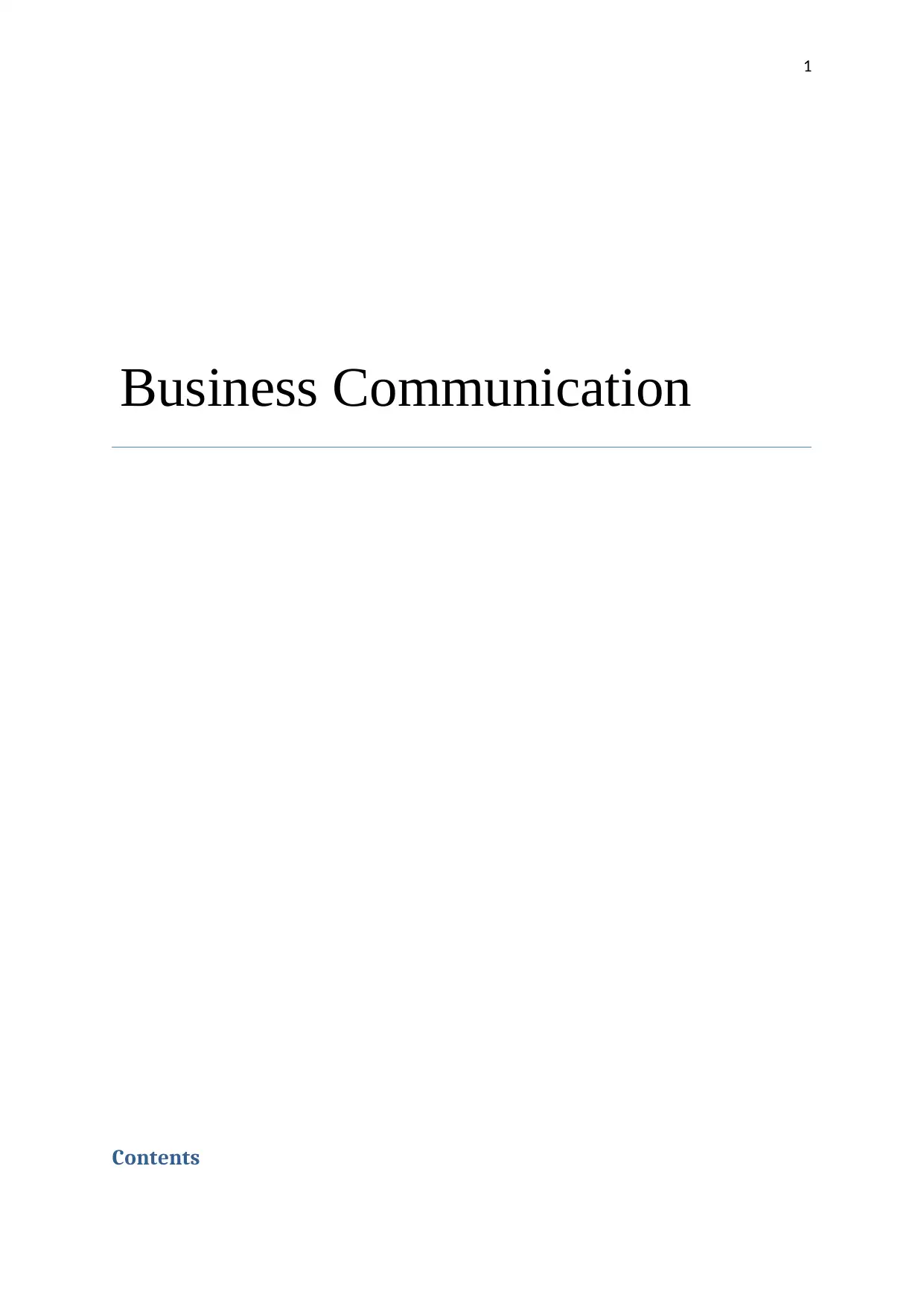
1
Business Communication
Contents
Business Communication
Contents
Paraphrase This Document
Need a fresh take? Get an instant paraphrase of this document with our AI Paraphraser
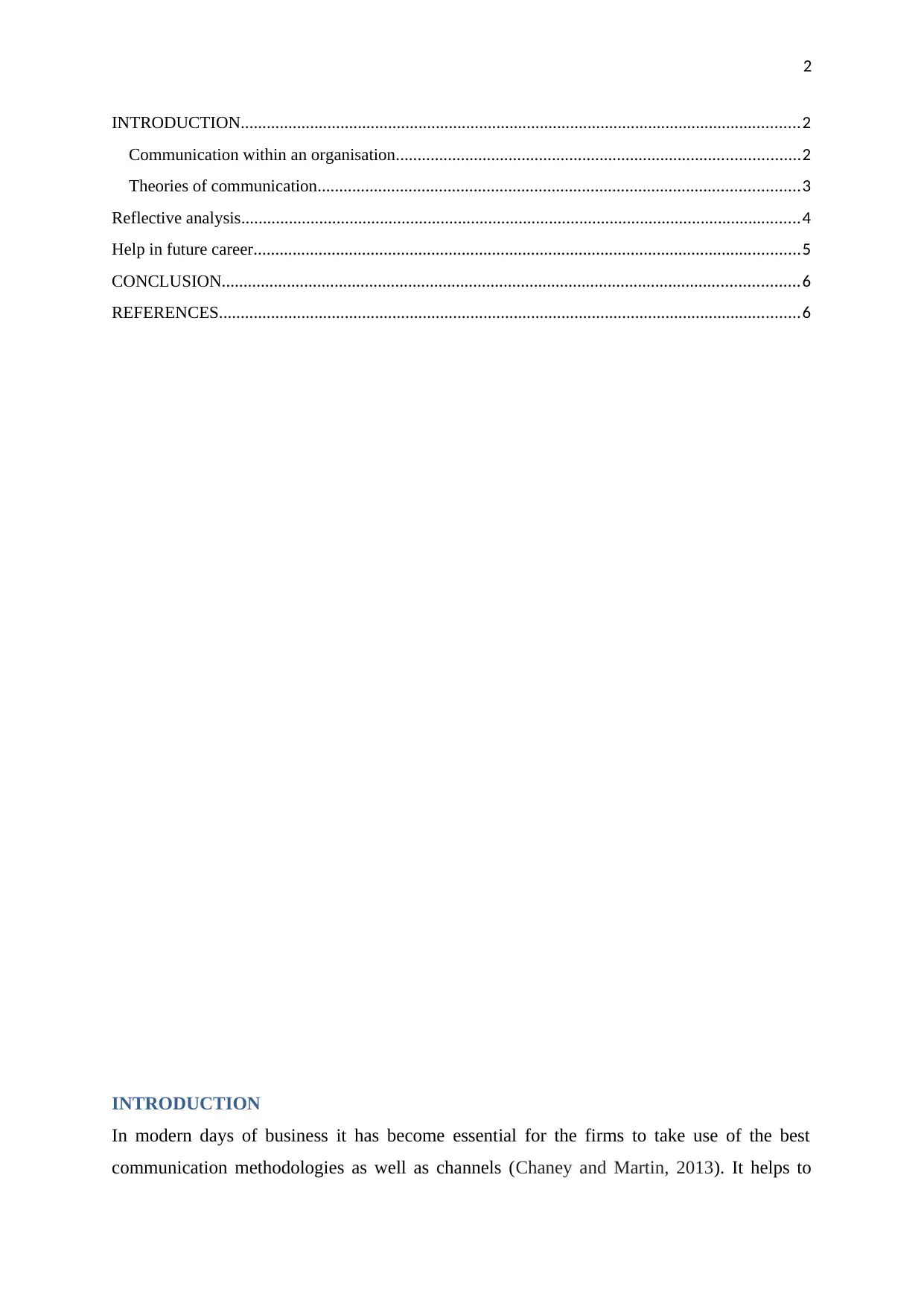
2
INTRODUCTION.................................................................................................................................2
Communication within an organisation.............................................................................................2
Theories of communication...............................................................................................................3
Reflective analysis.................................................................................................................................4
Help in future career..............................................................................................................................5
CONCLUSION.....................................................................................................................................6
REFERENCES......................................................................................................................................6
INTRODUCTION
In modern days of business it has become essential for the firms to take use of the best
communication methodologies as well as channels (Chaney and Martin, 2013). It helps to
INTRODUCTION.................................................................................................................................2
Communication within an organisation.............................................................................................2
Theories of communication...............................................................................................................3
Reflective analysis.................................................................................................................................4
Help in future career..............................................................................................................................5
CONCLUSION.....................................................................................................................................6
REFERENCES......................................................................................................................................6
INTRODUCTION
In modern days of business it has become essential for the firms to take use of the best
communication methodologies as well as channels (Chaney and Martin, 2013). It helps to
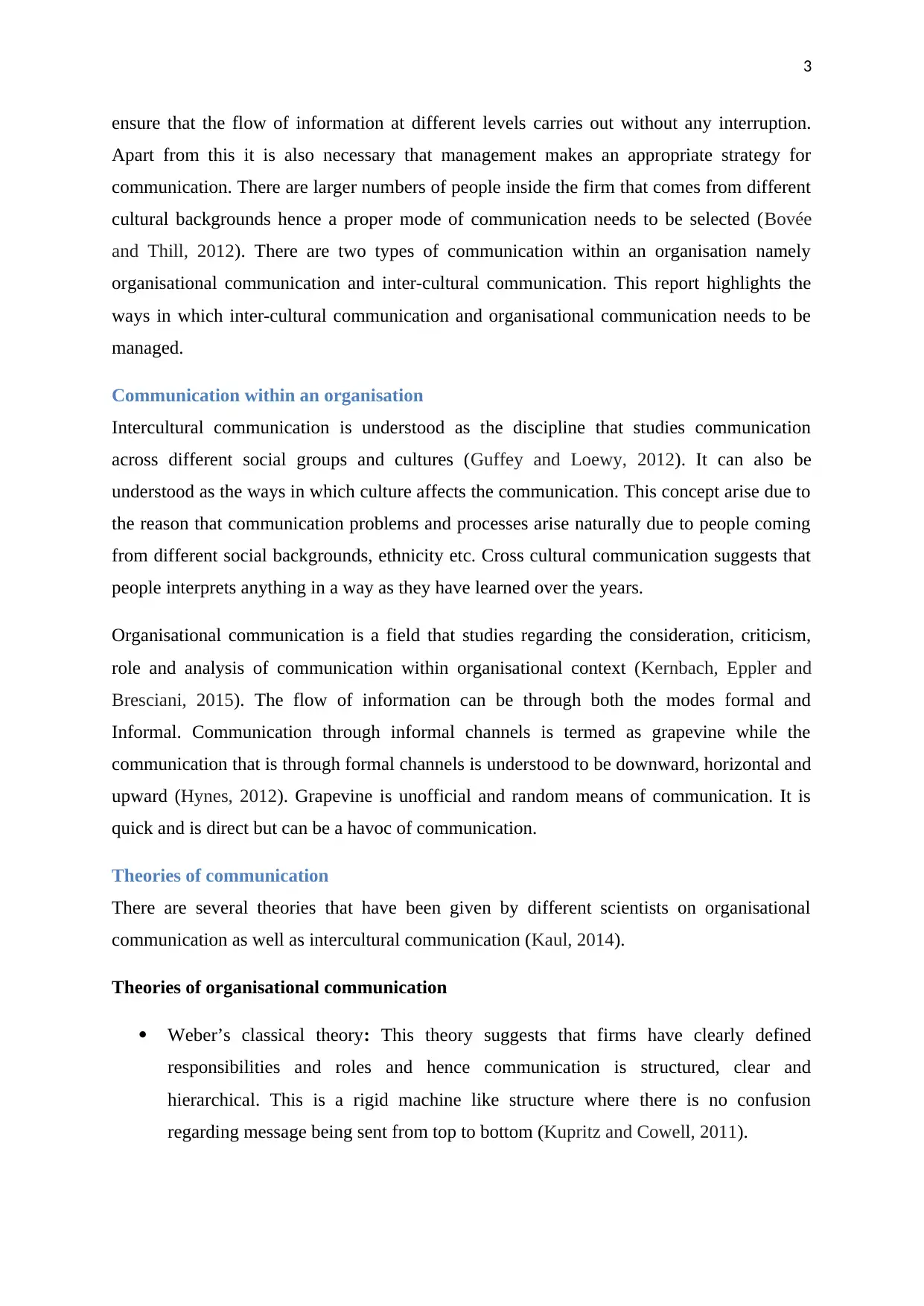
3
ensure that the flow of information at different levels carries out without any interruption.
Apart from this it is also necessary that management makes an appropriate strategy for
communication. There are larger numbers of people inside the firm that comes from different
cultural backgrounds hence a proper mode of communication needs to be selected (Bovée
and Thill, 2012). There are two types of communication within an organisation namely
organisational communication and inter-cultural communication. This report highlights the
ways in which inter-cultural communication and organisational communication needs to be
managed.
Communication within an organisation
Intercultural communication is understood as the discipline that studies communication
across different social groups and cultures (Guffey and Loewy, 2012). It can also be
understood as the ways in which culture affects the communication. This concept arise due to
the reason that communication problems and processes arise naturally due to people coming
from different social backgrounds, ethnicity etc. Cross cultural communication suggests that
people interprets anything in a way as they have learned over the years.
Organisational communication is a field that studies regarding the consideration, criticism,
role and analysis of communication within organisational context (Kernbach, Eppler and
Bresciani, 2015). The flow of information can be through both the modes formal and
Informal. Communication through informal channels is termed as grapevine while the
communication that is through formal channels is understood to be downward, horizontal and
upward (Hynes, 2012). Grapevine is unofficial and random means of communication. It is
quick and is direct but can be a havoc of communication.
Theories of communication
There are several theories that have been given by different scientists on organisational
communication as well as intercultural communication (Kaul, 2014).
Theories of organisational communication
Weber’s classical theory: This theory suggests that firms have clearly defined
responsibilities and roles and hence communication is structured, clear and
hierarchical. This is a rigid machine like structure where there is no confusion
regarding message being sent from top to bottom (Kupritz and Cowell, 2011).
ensure that the flow of information at different levels carries out without any interruption.
Apart from this it is also necessary that management makes an appropriate strategy for
communication. There are larger numbers of people inside the firm that comes from different
cultural backgrounds hence a proper mode of communication needs to be selected (Bovée
and Thill, 2012). There are two types of communication within an organisation namely
organisational communication and inter-cultural communication. This report highlights the
ways in which inter-cultural communication and organisational communication needs to be
managed.
Communication within an organisation
Intercultural communication is understood as the discipline that studies communication
across different social groups and cultures (Guffey and Loewy, 2012). It can also be
understood as the ways in which culture affects the communication. This concept arise due to
the reason that communication problems and processes arise naturally due to people coming
from different social backgrounds, ethnicity etc. Cross cultural communication suggests that
people interprets anything in a way as they have learned over the years.
Organisational communication is a field that studies regarding the consideration, criticism,
role and analysis of communication within organisational context (Kernbach, Eppler and
Bresciani, 2015). The flow of information can be through both the modes formal and
Informal. Communication through informal channels is termed as grapevine while the
communication that is through formal channels is understood to be downward, horizontal and
upward (Hynes, 2012). Grapevine is unofficial and random means of communication. It is
quick and is direct but can be a havoc of communication.
Theories of communication
There are several theories that have been given by different scientists on organisational
communication as well as intercultural communication (Kaul, 2014).
Theories of organisational communication
Weber’s classical theory: This theory suggests that firms have clearly defined
responsibilities and roles and hence communication is structured, clear and
hierarchical. This is a rigid machine like structure where there is no confusion
regarding message being sent from top to bottom (Kupritz and Cowell, 2011).
⊘ This is a preview!⊘
Do you want full access?
Subscribe today to unlock all pages.

Trusted by 1+ million students worldwide
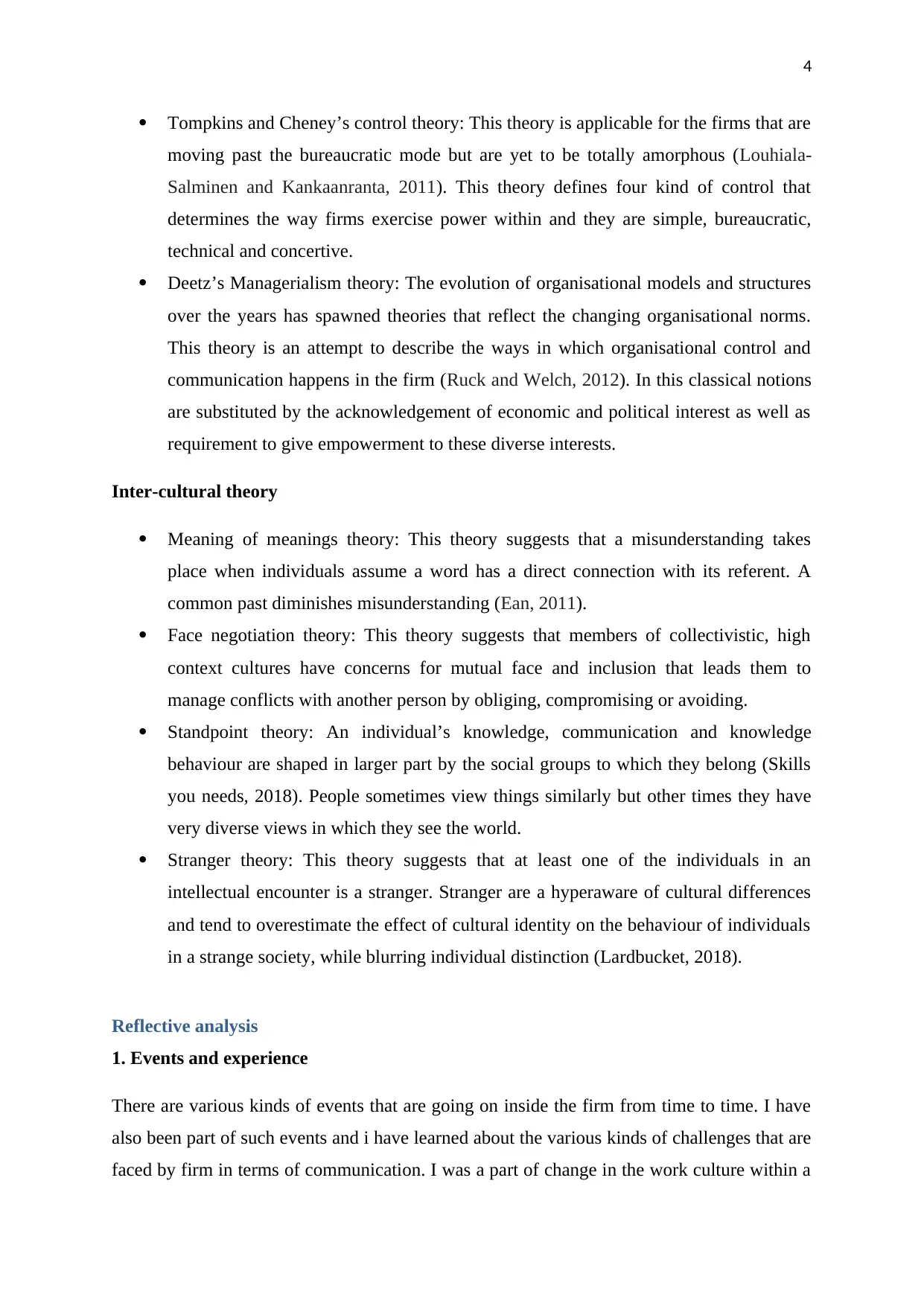
4
Tompkins and Cheney’s control theory: This theory is applicable for the firms that are
moving past the bureaucratic mode but are yet to be totally amorphous (Louhiala-
Salminen and Kankaanranta, 2011). This theory defines four kind of control that
determines the way firms exercise power within and they are simple, bureaucratic,
technical and concertive.
Deetz’s Managerialism theory: The evolution of organisational models and structures
over the years has spawned theories that reflect the changing organisational norms.
This theory is an attempt to describe the ways in which organisational control and
communication happens in the firm (Ruck and Welch, 2012). In this classical notions
are substituted by the acknowledgement of economic and political interest as well as
requirement to give empowerment to these diverse interests.
Inter-cultural theory
Meaning of meanings theory: This theory suggests that a misunderstanding takes
place when individuals assume a word has a direct connection with its referent. A
common past diminishes misunderstanding (Ean, 2011).
Face negotiation theory: This theory suggests that members of collectivistic, high
context cultures have concerns for mutual face and inclusion that leads them to
manage conflicts with another person by obliging, compromising or avoiding.
Standpoint theory: An individual’s knowledge, communication and knowledge
behaviour are shaped in larger part by the social groups to which they belong (Skills
you needs, 2018). People sometimes view things similarly but other times they have
very diverse views in which they see the world.
Stranger theory: This theory suggests that at least one of the individuals in an
intellectual encounter is a stranger. Stranger are a hyperaware of cultural differences
and tend to overestimate the effect of cultural identity on the behaviour of individuals
in a strange society, while blurring individual distinction (Lardbucket, 2018).
Reflective analysis
1. Events and experience
There are various kinds of events that are going on inside the firm from time to time. I have
also been part of such events and i have learned about the various kinds of challenges that are
faced by firm in terms of communication. I was a part of change in the work culture within a
Tompkins and Cheney’s control theory: This theory is applicable for the firms that are
moving past the bureaucratic mode but are yet to be totally amorphous (Louhiala-
Salminen and Kankaanranta, 2011). This theory defines four kind of control that
determines the way firms exercise power within and they are simple, bureaucratic,
technical and concertive.
Deetz’s Managerialism theory: The evolution of organisational models and structures
over the years has spawned theories that reflect the changing organisational norms.
This theory is an attempt to describe the ways in which organisational control and
communication happens in the firm (Ruck and Welch, 2012). In this classical notions
are substituted by the acknowledgement of economic and political interest as well as
requirement to give empowerment to these diverse interests.
Inter-cultural theory
Meaning of meanings theory: This theory suggests that a misunderstanding takes
place when individuals assume a word has a direct connection with its referent. A
common past diminishes misunderstanding (Ean, 2011).
Face negotiation theory: This theory suggests that members of collectivistic, high
context cultures have concerns for mutual face and inclusion that leads them to
manage conflicts with another person by obliging, compromising or avoiding.
Standpoint theory: An individual’s knowledge, communication and knowledge
behaviour are shaped in larger part by the social groups to which they belong (Skills
you needs, 2018). People sometimes view things similarly but other times they have
very diverse views in which they see the world.
Stranger theory: This theory suggests that at least one of the individuals in an
intellectual encounter is a stranger. Stranger are a hyperaware of cultural differences
and tend to overestimate the effect of cultural identity on the behaviour of individuals
in a strange society, while blurring individual distinction (Lardbucket, 2018).
Reflective analysis
1. Events and experience
There are various kinds of events that are going on inside the firm from time to time. I have
also been part of such events and i have learned about the various kinds of challenges that are
faced by firm in terms of communication. I was a part of change in the work culture within a
Paraphrase This Document
Need a fresh take? Get an instant paraphrase of this document with our AI Paraphraser
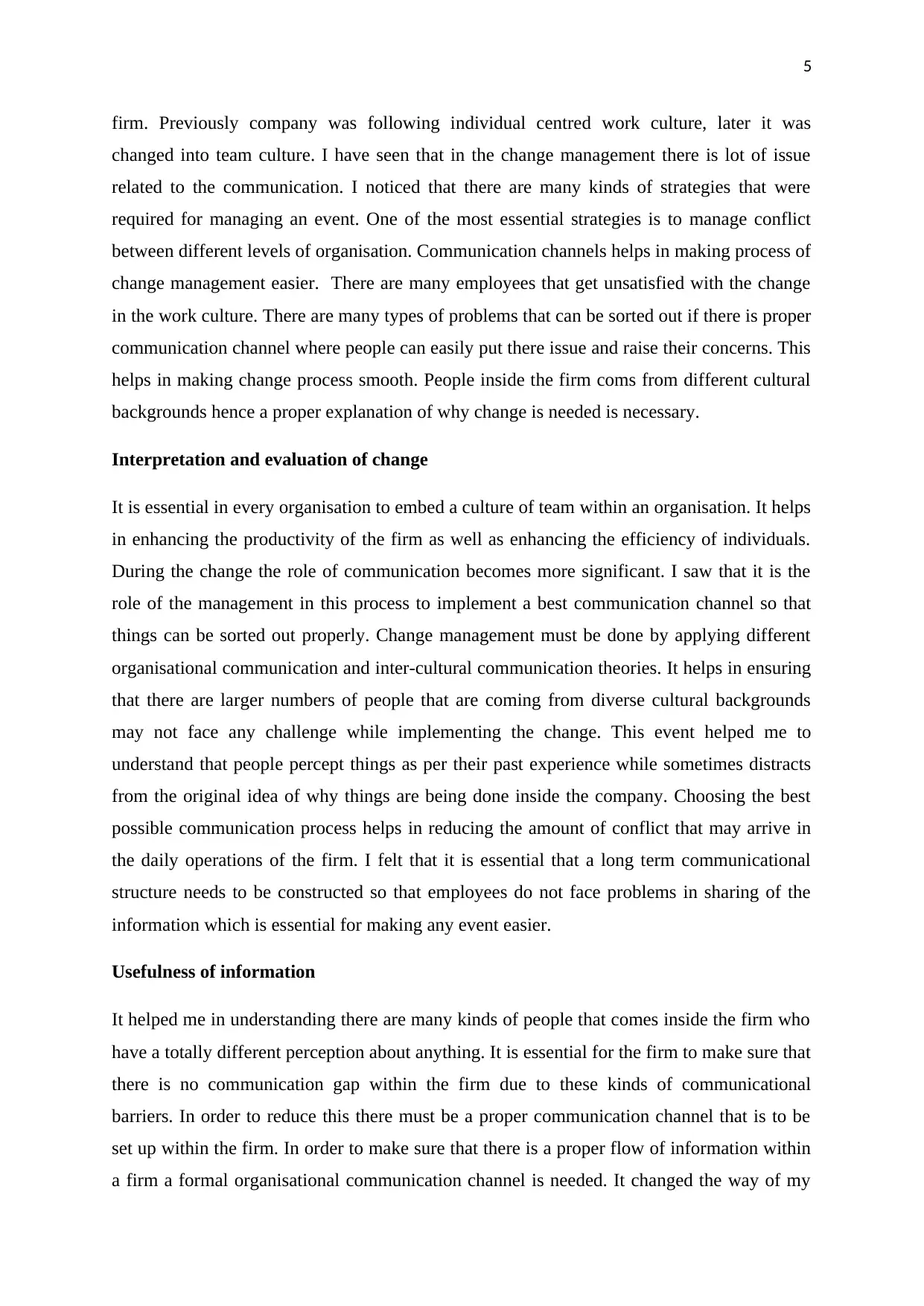
5
firm. Previously company was following individual centred work culture, later it was
changed into team culture. I have seen that in the change management there is lot of issue
related to the communication. I noticed that there are many kinds of strategies that were
required for managing an event. One of the most essential strategies is to manage conflict
between different levels of organisation. Communication channels helps in making process of
change management easier. There are many employees that get unsatisfied with the change
in the work culture. There are many types of problems that can be sorted out if there is proper
communication channel where people can easily put there issue and raise their concerns. This
helps in making change process smooth. People inside the firm coms from different cultural
backgrounds hence a proper explanation of why change is needed is necessary.
Interpretation and evaluation of change
It is essential in every organisation to embed a culture of team within an organisation. It helps
in enhancing the productivity of the firm as well as enhancing the efficiency of individuals.
During the change the role of communication becomes more significant. I saw that it is the
role of the management in this process to implement a best communication channel so that
things can be sorted out properly. Change management must be done by applying different
organisational communication and inter-cultural communication theories. It helps in ensuring
that there are larger numbers of people that are coming from diverse cultural backgrounds
may not face any challenge while implementing the change. This event helped me to
understand that people percept things as per their past experience while sometimes distracts
from the original idea of why things are being done inside the company. Choosing the best
possible communication process helps in reducing the amount of conflict that may arrive in
the daily operations of the firm. I felt that it is essential that a long term communicational
structure needs to be constructed so that employees do not face problems in sharing of the
information which is essential for making any event easier.
Usefulness of information
It helped me in understanding there are many kinds of people that comes inside the firm who
have a totally different perception about anything. It is essential for the firm to make sure that
there is no communication gap within the firm due to these kinds of communicational
barriers. In order to reduce this there must be a proper communication channel that is to be
set up within the firm. In order to make sure that there is a proper flow of information within
a firm a formal organisational communication channel is needed. It changed the way of my
firm. Previously company was following individual centred work culture, later it was
changed into team culture. I have seen that in the change management there is lot of issue
related to the communication. I noticed that there are many kinds of strategies that were
required for managing an event. One of the most essential strategies is to manage conflict
between different levels of organisation. Communication channels helps in making process of
change management easier. There are many employees that get unsatisfied with the change
in the work culture. There are many types of problems that can be sorted out if there is proper
communication channel where people can easily put there issue and raise their concerns. This
helps in making change process smooth. People inside the firm coms from different cultural
backgrounds hence a proper explanation of why change is needed is necessary.
Interpretation and evaluation of change
It is essential in every organisation to embed a culture of team within an organisation. It helps
in enhancing the productivity of the firm as well as enhancing the efficiency of individuals.
During the change the role of communication becomes more significant. I saw that it is the
role of the management in this process to implement a best communication channel so that
things can be sorted out properly. Change management must be done by applying different
organisational communication and inter-cultural communication theories. It helps in ensuring
that there are larger numbers of people that are coming from diverse cultural backgrounds
may not face any challenge while implementing the change. This event helped me to
understand that people percept things as per their past experience while sometimes distracts
from the original idea of why things are being done inside the company. Choosing the best
possible communication process helps in reducing the amount of conflict that may arrive in
the daily operations of the firm. I felt that it is essential that a long term communicational
structure needs to be constructed so that employees do not face problems in sharing of the
information which is essential for making any event easier.
Usefulness of information
It helped me in understanding there are many kinds of people that comes inside the firm who
have a totally different perception about anything. It is essential for the firm to make sure that
there is no communication gap within the firm due to these kinds of communicational
barriers. In order to reduce this there must be a proper communication channel that is to be
set up within the firm. In order to make sure that there is a proper flow of information within
a firm a formal organisational communication channel is needed. It changed the way of my
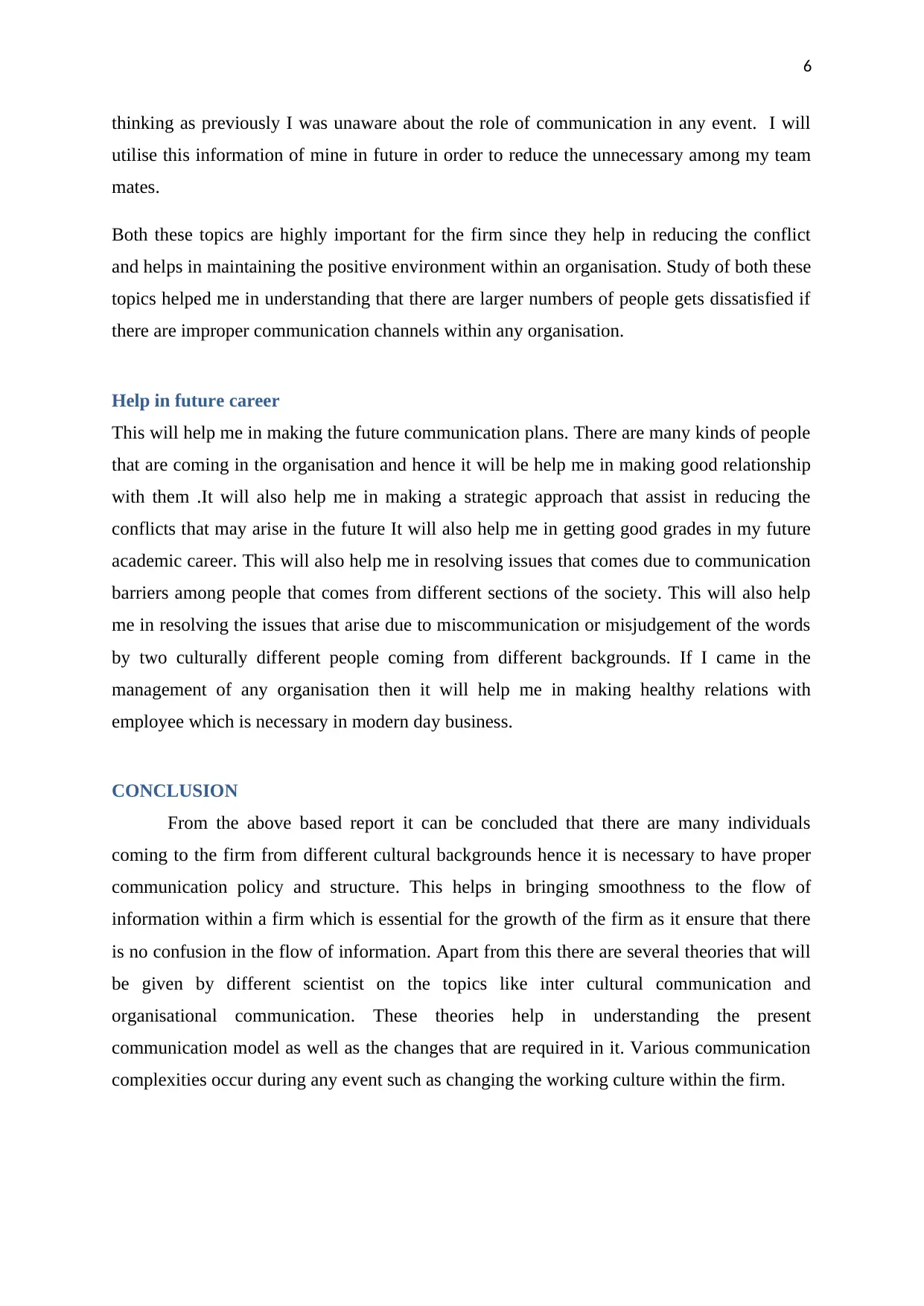
6
thinking as previously I was unaware about the role of communication in any event. I will
utilise this information of mine in future in order to reduce the unnecessary among my team
mates.
Both these topics are highly important for the firm since they help in reducing the conflict
and helps in maintaining the positive environment within an organisation. Study of both these
topics helped me in understanding that there are larger numbers of people gets dissatisfied if
there are improper communication channels within any organisation.
Help in future career
This will help me in making the future communication plans. There are many kinds of people
that are coming in the organisation and hence it will be help me in making good relationship
with them .It will also help me in making a strategic approach that assist in reducing the
conflicts that may arise in the future It will also help me in getting good grades in my future
academic career. This will also help me in resolving issues that comes due to communication
barriers among people that comes from different sections of the society. This will also help
me in resolving the issues that arise due to miscommunication or misjudgement of the words
by two culturally different people coming from different backgrounds. If I came in the
management of any organisation then it will help me in making healthy relations with
employee which is necessary in modern day business.
CONCLUSION
From the above based report it can be concluded that there are many individuals
coming to the firm from different cultural backgrounds hence it is necessary to have proper
communication policy and structure. This helps in bringing smoothness to the flow of
information within a firm which is essential for the growth of the firm as it ensure that there
is no confusion in the flow of information. Apart from this there are several theories that will
be given by different scientist on the topics like inter cultural communication and
organisational communication. These theories help in understanding the present
communication model as well as the changes that are required in it. Various communication
complexities occur during any event such as changing the working culture within the firm.
thinking as previously I was unaware about the role of communication in any event. I will
utilise this information of mine in future in order to reduce the unnecessary among my team
mates.
Both these topics are highly important for the firm since they help in reducing the conflict
and helps in maintaining the positive environment within an organisation. Study of both these
topics helped me in understanding that there are larger numbers of people gets dissatisfied if
there are improper communication channels within any organisation.
Help in future career
This will help me in making the future communication plans. There are many kinds of people
that are coming in the organisation and hence it will be help me in making good relationship
with them .It will also help me in making a strategic approach that assist in reducing the
conflicts that may arise in the future It will also help me in getting good grades in my future
academic career. This will also help me in resolving issues that comes due to communication
barriers among people that comes from different sections of the society. This will also help
me in resolving the issues that arise due to miscommunication or misjudgement of the words
by two culturally different people coming from different backgrounds. If I came in the
management of any organisation then it will help me in making healthy relations with
employee which is necessary in modern day business.
CONCLUSION
From the above based report it can be concluded that there are many individuals
coming to the firm from different cultural backgrounds hence it is necessary to have proper
communication policy and structure. This helps in bringing smoothness to the flow of
information within a firm which is essential for the growth of the firm as it ensure that there
is no confusion in the flow of information. Apart from this there are several theories that will
be given by different scientist on the topics like inter cultural communication and
organisational communication. These theories help in understanding the present
communication model as well as the changes that are required in it. Various communication
complexities occur during any event such as changing the working culture within the firm.
⊘ This is a preview!⊘
Do you want full access?
Subscribe today to unlock all pages.

Trusted by 1+ million students worldwide
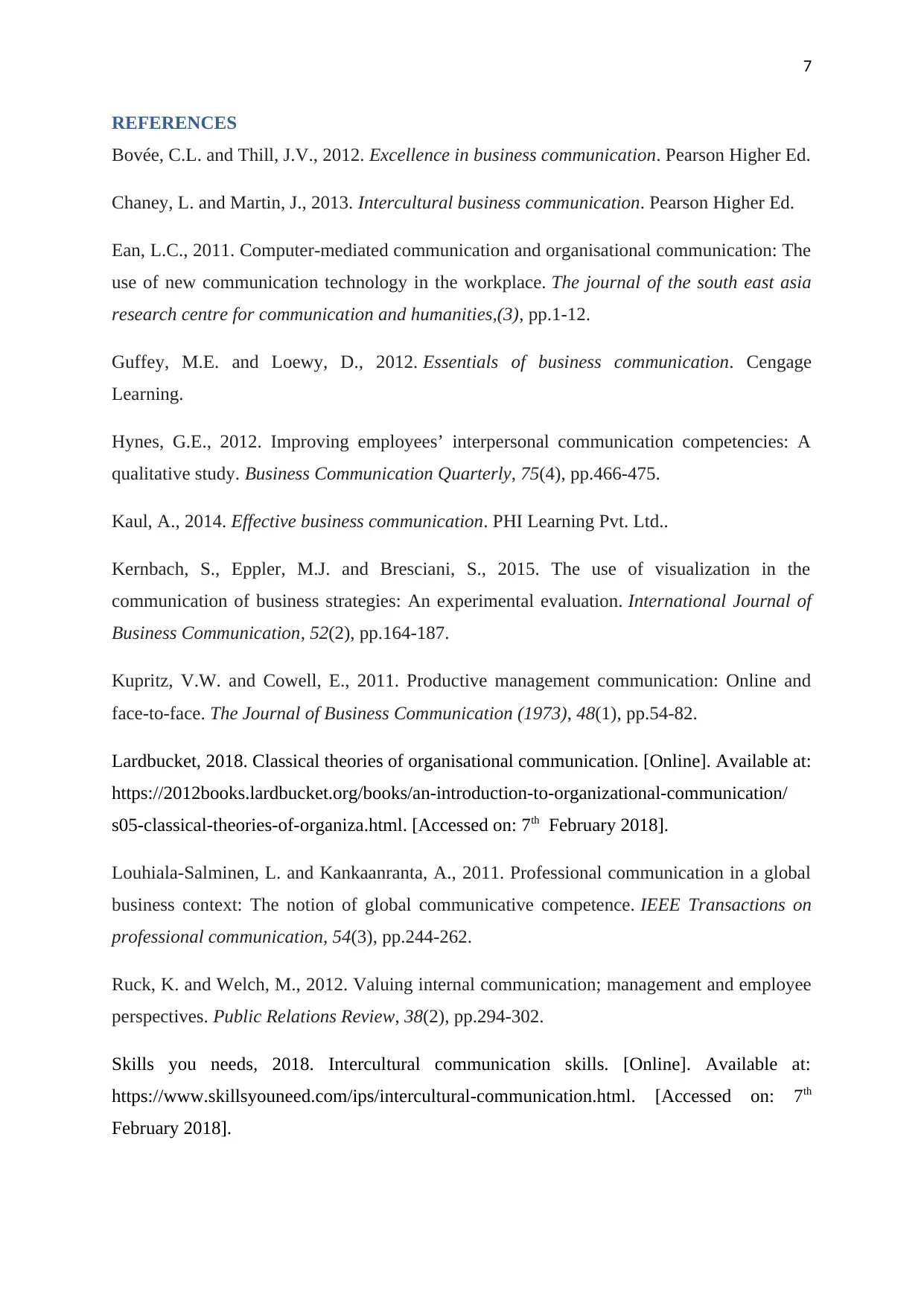
7
REFERENCES
Bovée, C.L. and Thill, J.V., 2012. Excellence in business communication. Pearson Higher Ed.
Chaney, L. and Martin, J., 2013. Intercultural business communication. Pearson Higher Ed.
Ean, L.C., 2011. Computer-mediated communication and organisational communication: The
use of new communication technology in the workplace. The journal of the south east asia
research centre for communication and humanities,(3), pp.1-12.
Guffey, M.E. and Loewy, D., 2012. Essentials of business communication. Cengage
Learning.
Hynes, G.E., 2012. Improving employees’ interpersonal communication competencies: A
qualitative study. Business Communication Quarterly, 75(4), pp.466-475.
Kaul, A., 2014. Effective business communication. PHI Learning Pvt. Ltd..
Kernbach, S., Eppler, M.J. and Bresciani, S., 2015. The use of visualization in the
communication of business strategies: An experimental evaluation. International Journal of
Business Communication, 52(2), pp.164-187.
Kupritz, V.W. and Cowell, E., 2011. Productive management communication: Online and
face-to-face. The Journal of Business Communication (1973), 48(1), pp.54-82.
Lardbucket, 2018. Classical theories of organisational communication. [Online]. Available at:
https://2012books.lardbucket.org/books/an-introduction-to-organizational-communication/
s05-classical-theories-of-organiza.html. [Accessed on: 7th February 2018].
Louhiala-Salminen, L. and Kankaanranta, A., 2011. Professional communication in a global
business context: The notion of global communicative competence. IEEE Transactions on
professional communication, 54(3), pp.244-262.
Ruck, K. and Welch, M., 2012. Valuing internal communication; management and employee
perspectives. Public Relations Review, 38(2), pp.294-302.
Skills you needs, 2018. Intercultural communication skills. [Online]. Available at:
https://www.skillsyouneed.com/ips/intercultural-communication.html. [Accessed on: 7th
February 2018].
REFERENCES
Bovée, C.L. and Thill, J.V., 2012. Excellence in business communication. Pearson Higher Ed.
Chaney, L. and Martin, J., 2013. Intercultural business communication. Pearson Higher Ed.
Ean, L.C., 2011. Computer-mediated communication and organisational communication: The
use of new communication technology in the workplace. The journal of the south east asia
research centre for communication and humanities,(3), pp.1-12.
Guffey, M.E. and Loewy, D., 2012. Essentials of business communication. Cengage
Learning.
Hynes, G.E., 2012. Improving employees’ interpersonal communication competencies: A
qualitative study. Business Communication Quarterly, 75(4), pp.466-475.
Kaul, A., 2014. Effective business communication. PHI Learning Pvt. Ltd..
Kernbach, S., Eppler, M.J. and Bresciani, S., 2015. The use of visualization in the
communication of business strategies: An experimental evaluation. International Journal of
Business Communication, 52(2), pp.164-187.
Kupritz, V.W. and Cowell, E., 2011. Productive management communication: Online and
face-to-face. The Journal of Business Communication (1973), 48(1), pp.54-82.
Lardbucket, 2018. Classical theories of organisational communication. [Online]. Available at:
https://2012books.lardbucket.org/books/an-introduction-to-organizational-communication/
s05-classical-theories-of-organiza.html. [Accessed on: 7th February 2018].
Louhiala-Salminen, L. and Kankaanranta, A., 2011. Professional communication in a global
business context: The notion of global communicative competence. IEEE Transactions on
professional communication, 54(3), pp.244-262.
Ruck, K. and Welch, M., 2012. Valuing internal communication; management and employee
perspectives. Public Relations Review, 38(2), pp.294-302.
Skills you needs, 2018. Intercultural communication skills. [Online]. Available at:
https://www.skillsyouneed.com/ips/intercultural-communication.html. [Accessed on: 7th
February 2018].
1 out of 7
Related Documents
Your All-in-One AI-Powered Toolkit for Academic Success.
+13062052269
info@desklib.com
Available 24*7 on WhatsApp / Email
![[object Object]](/_next/static/media/star-bottom.7253800d.svg)
Unlock your academic potential
Copyright © 2020–2025 A2Z Services. All Rights Reserved. Developed and managed by ZUCOL.





